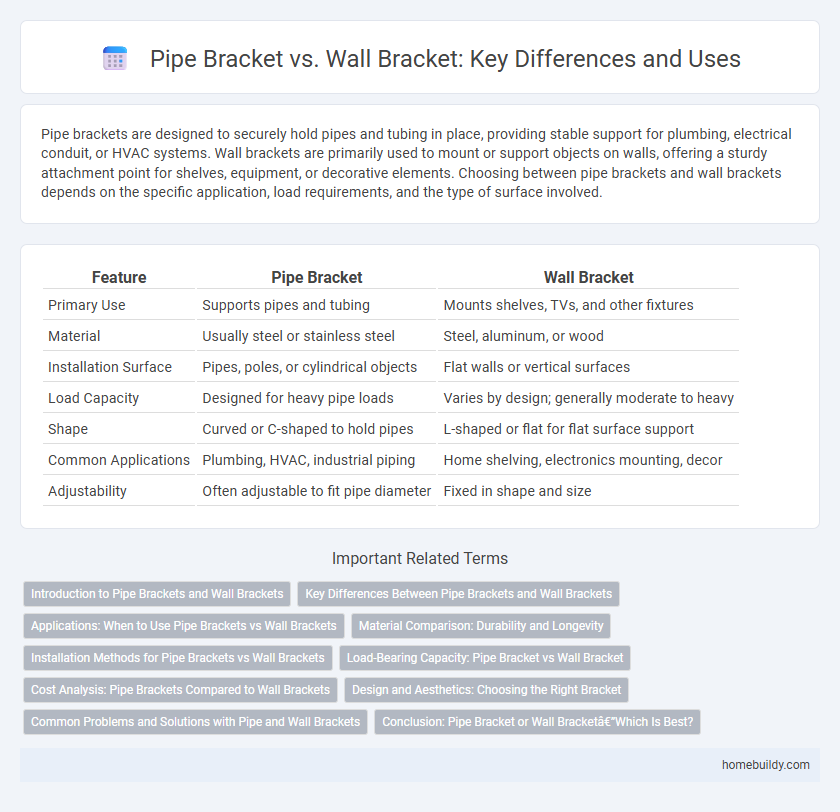Pipe brackets are designed to securely hold pipes and tubing in place, providing stable support for plumbing, electrical conduit, or HVAC systems. Wall brackets are primarily used to mount or support objects on walls, offering a sturdy attachment point for shelves, equipment, or decorative elements. Choosing between pipe brackets and wall brackets depends on the specific application, load requirements, and the type of surface involved.
Table of Comparison
| Feature | Pipe Bracket | Wall Bracket |
|---|---|---|
| Primary Use | Supports pipes and tubing | Mounts shelves, TVs, and other fixtures |
| Material | Usually steel or stainless steel | Steel, aluminum, or wood |
| Installation Surface | Pipes, poles, or cylindrical objects | Flat walls or vertical surfaces |
| Load Capacity | Designed for heavy pipe loads | Varies by design; generally moderate to heavy |
| Shape | Curved or C-shaped to hold pipes | L-shaped or flat for flat surface support |
| Common Applications | Plumbing, HVAC, industrial piping | Home shelving, electronics mounting, decor |
| Adjustability | Often adjustable to fit pipe diameter | Fixed in shape and size |
Introduction to Pipe Brackets and Wall Brackets
Pipe brackets are specialized supports designed to secure pipes firmly in plumbing, HVAC, and industrial installations, ensuring stability and alignment. Wall brackets, while also used for support, are generally more versatile and installed directly onto walls to hold various fixtures, including pipes, shelves, or cables. Choosing between pipe brackets and wall brackets depends on load requirements, installation surfaces, and the specific purpose within the construction or mechanical setup.
Key Differences Between Pipe Brackets and Wall Brackets
Pipe brackets are specifically designed to support and secure pipes, featuring curved or semicircular shapes to fit around cylindrical surfaces, whereas wall brackets are flat or angled supports intended to mount objects directly onto walls. The material and load-bearing capacity differ significantly; pipe brackets often use corrosion-resistant metals for demanding plumbing applications, while wall brackets vary widely based on the mounted object's weight and function. Installation methods also differ, with pipe brackets typically clamping around pipes and wall brackets anchoring through screws or bolts into wall studs or masonry.
Applications: When to Use Pipe Brackets vs Wall Brackets
Pipe brackets are ideal for securing pipes along ceilings or beams, providing strong lateral support in industrial and plumbing applications where overhead pipe stability is critical. Wall brackets are best suited for mounting pipes directly onto vertical surfaces, optimizing space in residential plumbing and HVAC installations by keeping pipes flush against walls. Selecting between pipe brackets and wall brackets depends on structural requirements and spatial constraints, with pipe brackets preferred for overhead stability and wall brackets for compact, wall-attached setups.
Material Comparison: Durability and Longevity
Pipe brackets are typically made from galvanized steel or stainless steel, offering superior resistance to corrosion and mechanical stress compared to many wall brackets, which are often constructed from plastic or lighter metals. The durability of pipe brackets ensures prolonged longevity under harsh environmental conditions, making them ideal for heavy-duty applications. Wall brackets, while easier to install and more cost-effective, generally lack the robustness and lifespan provided by the high-grade materials used in pipe brackets.
Installation Methods for Pipe Brackets vs Wall Brackets
Pipe brackets are installed by securing the pipe directly to the bracket, which is then anchored to structural elements like beams or columns using bolts or clamps, providing strong support for horizontal or vertical piping systems. Wall brackets, on the other hand, are mounted directly onto vertical surfaces such as walls using anchors or screws, requiring precise alignment to ensure the pipe's stability and minimize vibrations. Installation of pipe brackets typically demands careful positioning to accommodate pipe movement and thermal expansion, whereas wall brackets need solid wall substrates to ensure load-bearing capacity and durability.
Load-Bearing Capacity: Pipe Bracket vs Wall Bracket
Pipe brackets typically offer greater load-bearing capacity compared to wall brackets due to their robust design and direct attachment to structural elements such as beams or columns. Wall brackets, while convenient for lighter loads, rely heavily on the integrity of the wall material, which can limit their overall strength and stability. Selecting a pipe bracket enhances support for heavy or industrial piping systems by minimizing stress on the mounting surface and preventing deformation or displacement.
Cost Analysis: Pipe Brackets Compared to Wall Brackets
Pipe brackets typically offer a more cost-effective solution compared to wall brackets due to lower material and installation expenses, especially in large-scale piping projects. Wall brackets often require more complex mounting hardware and additional labor, increasing overall project costs. Choosing pipe brackets can reduce initial investment while maintaining adequate support strength for various piping systems.
Design and Aesthetics: Choosing the Right Bracket
Pipe brackets feature a robust, functional design optimized for securely holding pipes with minimal visual distraction, making them ideal for industrial and utilitarian settings. Wall brackets often incorporate sleek lines and decorative elements, offering enhanced aesthetic appeal suitable for residential or commercial interiors. Selecting between pipe brackets and wall brackets depends on balancing structural support requirements with the desired visual integration into the surrounding environment.
Common Problems and Solutions with Pipe and Wall Brackets
Pipe brackets often face challenges like corrosion and inadequate load distribution, which can lead to pipe misalignment or damage. Wall brackets may suffer from weak anchoring or surface incompatibility, causing bracket loosening or wall damage over time. Utilizing corrosion-resistant materials and ensuring proper installation with suitable anchors can effectively resolve these common issues for both pipe and wall brackets.
Conclusion: Pipe Bracket or Wall Bracket—Which Is Best?
Pipe brackets provide strong support and stability for securing pipes in plumbing and construction, ideal for heavy-duty applications requiring precise alignment. Wall brackets offer greater versatility and ease of installation on various surfaces, making them suitable for lighter loads and flexible setups. Choosing between a pipe bracket and wall bracket depends on the load capacity, installation environment, and specific pipe system requirements.
pipe bracket vs wall bracket Infographic

 homebuildy.com
homebuildy.com